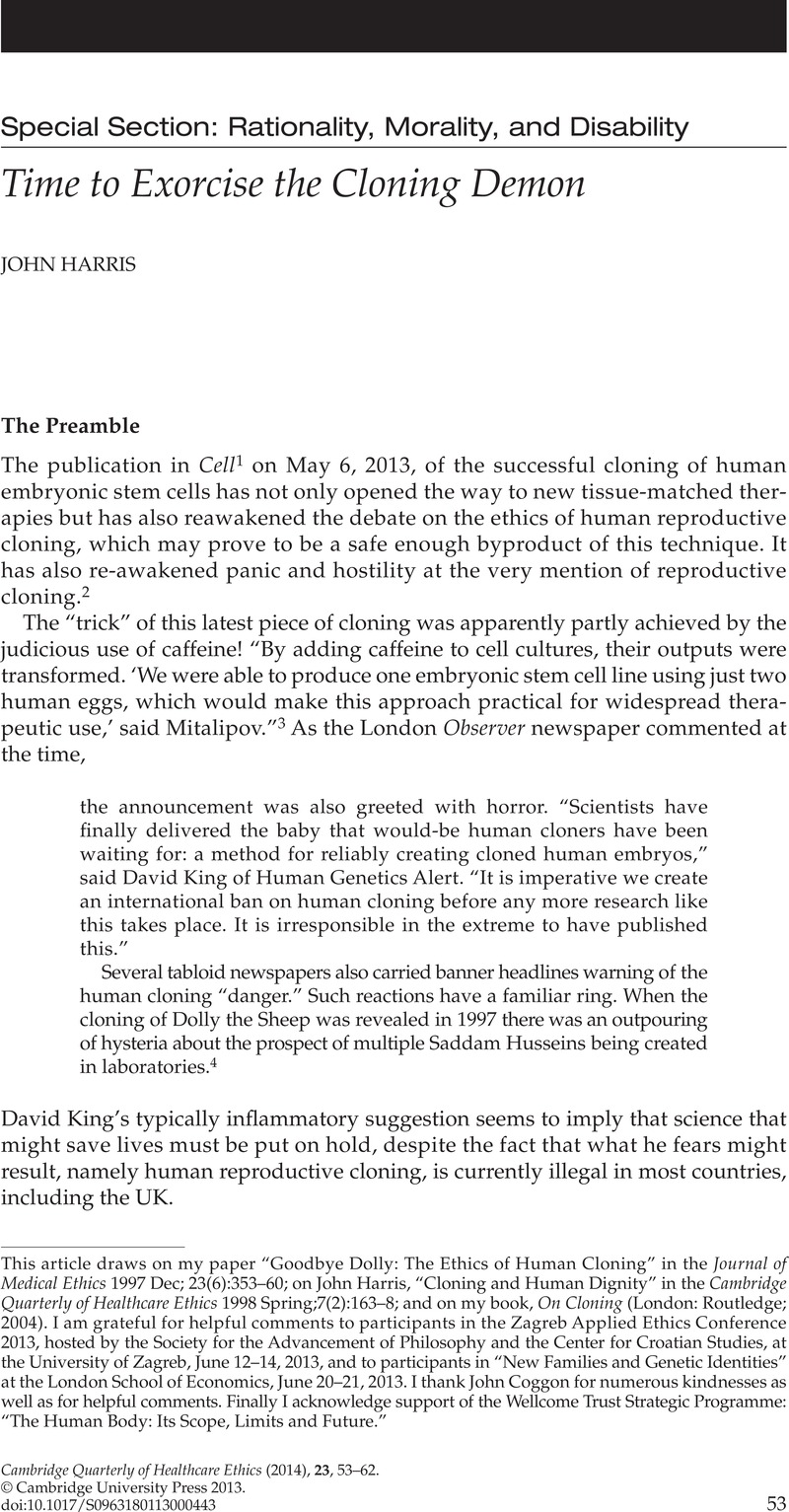Published online by Cambridge University Press: 20 November 2013

1. Tachibana M, Amato P, Sparman M, Gutierrez NM, Tippner-Hedges R, Ma H, et al. Human embryonic stem cells derived by somatic cell nuclear transfer. Cell 2013; available at http://dx.doi.org/10.1016/j.cell.2013.05.006 (last accessed 11 Oct 2013).
2. An Observer piece, by their science editor Robin McKie, also featured quotes from an interview with this author: McKie R. Human cloning developments raise hopes for new treatments. Observer 2013 May 18; available at http://www.guardian.co.uk/science/2013/may/18/human-cloning-heart-disease-genes (last accessed 11 Oct 2013).
3. See note 2, McKie 2013.
4. See note 2, McKie 2013.
5. Wilmut I, Schnieke AE, McWhir J, Kind AJ, Campbell KH. Viable offspring derived from fetal and adult mammalian cells. Nature 1997 Feb 27. Dolly the cloned sheep (5 July 1996–14 Feb 2003, R.I.P.).
6. See Cloning Human Beings: Report and Recommendations of the National Bioethics Advisory Commission. Rockville, MD; 1997 June.
7. From President Clinton’s weekly radio broadcast, reported in Bioworld Today 1998 Jan 13;9(7); available at http://www.bioworld.com/content/calls-legislation-follow-cloning-announcement (last accessed 11 Oct 2013). Interestingly, the National Bioethics Advisory Commission (see note 6 above) stated that it was unethical because it was unsafe. Either Clinton misread his advisor’s report or he decided to add “morally unacceptable” on top of the fact that it was untested and unsafe, rather than simply because it was untested and unsafe.
8. Bush, GW. Remarks by the President on Stem Cell Research. Washington, DC: The White House; 2001Google Scholar Aug 9; available at http://www.whitehouse.gov/news/releases/2001/08/20010809-2.html. (accessed 21 Aug 2001).
9. Ward M. Human Cloning: Washington: FDA claims oversight; Europe: Anti-cloning declarations get louder. BioCentury–the Bernstein Report on Biobusiness; 1998 Jan 19; available at http://www.biocentury.com/biotech-pharma-news/politics/1998-01-19/politics-and-policy-human-cloning-washington-fda-claims-oversight-europe-anti-cloning-declarations-get-louder-a8 (last accessed 11 Oct 2013).
10. The European Parliament. Resolution on Cloning. Motion dated 1997 Mar 11; passed 1997 Mar 13, at para. B.
11. See note 10, the European Parliament 1997, clause 1.
12. Council of Europe. Additional Protocol to the Convention for the Protection of Human Rights and Dignity of the Human Being with regard to the Application of Biology and Medicine, on the Prohibition of Cloning Human Beings. Paris, Article 1, 12.1.1998.
13. The Universal Declaration on the Human Genome and Human Rights. UNESCO; 1997 Dec 3 (pamphlet).
14. Harris, J. Goodbye Dolly: The ethics of human cloning. Journal of Medical Ethics 1997 Dec;23(6):353–60.CrossRefGoogle ScholarPubMed
15. Harris J. The Value of Life. London, UK: Routledge and Kegan Paul; 1985, chap. 6 and 8.
16. See note 14, Harris 1997.
17. See note 2, McKie 2013.
18. Google Trends. Google Trends; n.d.; available at http://www.google.com/trends/ (retrieved 6 Apr 2013). https://support.google.com/trends/answer/92768?hl=en&ref_topic=13975. https://support.google.com/trends/answer/87282?hl=en. https://support.google.com/trends/answer/87284?hl=en&ref_topic=13975.
19. See note 10, the European Parliament 1997; Paragraph B. available at http://www1.umn.edu/humanrts/instree/cloning1.html (last accessed 11 Oct 2013).
20. Ravelingien A, Pennings G. The right to know your genetic parents: From open-identity gamete donation to routine paternity testing. AJOB 2013;13(5):33–41.
21. The most reliable published article on the subject is Macintyre S, Sooman A. Non-paternity and prenatal genetic screening. The Lancet 1991;338(8771):869–71, and ensuing correspondence.
22. This figure is worked out from the figure provided on National Statistics Online (http://www.statistics.gov.uk/cci/nugget.asp?id=369) that there were 639,721 live births registered in England and Wales in 2004.
24. Heller J. Catch 22. London, UK: Vintage; 1994 [1961], at 511.
25. See, e.g., Steinman, G. Spontaneous monozygotic quadruplet pregnancy: An obstetric rarity. Obstetrics & Gynecology 1998:866.Google ScholarPubMed
26. In the literature I have so far found reference only to a rate of 1:80 births. See Sills ES, Moomjy M, Zaninovic M, Veeck LL, McGee M, Palermo GD, et al. Human zona pellucida micromanipulation and monozygotic twinning frequency after IVF. Human Reproduction 2000 Apr;15(4):890–5. This still seems to be the case. See http://www.reproductivepartners.com/blog/429/does-ivf-increase-the-chance-of-identical-monozygotic-twins.html (last accessed 11 Oct 2013). See also Herranz G. The timing of monozygotic twinning: A criticism of the common model. Zygote 2013. doi:10.1017/S0967199413000257.
27. http://www.livescience.com/21355-5-million-babies-born-ivf-technologies.html (last accessed 11 Oct 2013).
28. Kahn A. Clone mammals . . . clone man. Nature 1997 Mar;386:119.
29. See Harris J. Is cloning an attack on human dignity. Nature 1997 June 19;387:754.
30. Harris, J. On Cloning. London: Routledge; 2004, at 29-30.
31. From March of Dimes Global Report on Birth Defects. White Plains, NY: The March of Dimes Birth Defects Foundation; 2006; available at http://www.marchofdimes.org (last accessed 11 Oct 2013). Additional hundreds of thousands more are born with serious birth defects of postconception origin, including maternal exposure to environmental agents (teratogens), such as alcohol, rubella, syphilis, and iodine deficiency, that can harm a developing fetus.
32. In Dawkins, R. The Devil’s Chaplain. London: Phoenix; 2004, at 23–31Google Scholar. I use the summary of Dawkins that appears in Harris J. Enhancing Evolution. Princeton, NJ, and Oxford: Princeton University Press; 2007. I apologize for my frequent recourse to this wonderful example.
33. Harris J. Is there a coherent social conception of disability? Journal of Medical Ethics 2000 Apr;26(2):95–101.
34. For detail of my account, see Harris, J. Wonderwoman and Superman. Oxford: Oxford University Press; 1992.Google Scholar
35. Burley, J, Harris, J. Human cloning and child welfare. Journal of Medical Ethics 1999 Apr;25(2):108–14.CrossRefGoogle ScholarPubMed